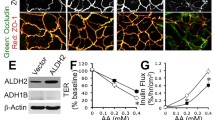Abstract
In a previous experiment (Isoda et al., 2001), we showed that the tight-junctional (TJ) permeability increase in Caco-2 cells during capsaicin exposure was through binding of the capsaicin molecule to a capsaicin receptor-like protein. In the present study, we examined how actin, which modulates TJ permeability, is influenced by capsaicin. We showed that after treatment of the Caco-2 cells with capsaicin, the volume of F-actin decreased. Moreover, we also examined protein kinase C (PKC) and heat shock protein 47 (HSP47), which act as probable second messengers in causing TJ permeability increase. We showed that after capsaicin treatment, HSP47 was activated. However, PKC activity was the same in both control and treatment setups. These results suggest that, while PKC is not involved, it is highly possible that HSP47plays a role in TJ permeability increase in intestinal Caco-2 cells exposed to capsaicin.
Similar content being viewed by others
References
Cheng Y, Razzaque MS, Nazneen A and Taguchi T (1998) Expression of heat shock protein 47 in gentamicin treated rats kidney. Int J Exp Pathol 79: 125–132.
Dadabay CJ, Patton E, Cooper JA and Pike LJ (1991) Lack of correlation between changes in polyphosphoinositide levels and actin/gelsolin complexes in A431 cells treated with epidermal growth factor. J Cell Biol 112: 1151–1156.
Diange L, Razzaque MS, Cheng M and Taguchi T (2002) The renal expression of Heat Shock Protein 47 and collagen in acute and chronic experimental diabetes in rat. Histochem J 33: 621–628.
Hashimoto K, Kawagishi H, Nakayama T and Shimizu M (1997) Effect of capsianoside, a diterpene glycoside, on tight-junctional permeability. Biochim Biophys Acta 1323: 281–290.
Holmes KC, Popp D, Gebhard W and Kabsch W (1990) Atomic model of the actin filament. Nature 347: 44–49.
Isoda H, Han JK, Tominaga M and Maekawa T (2001) Effect of capsaicin on human intestinal cell line Caco-2. Cytotechnology 36: 155–161.
Koide T, Asada S and Nagata K (1999) Substrate recognition of collagen-specific molecular chaperone HSP47. Structural requirements and binding regulation. J Biol Chem 274: 34523–34526.
Mohammed T, Margaret RB and Neil JB (2000) Hsp47: A molecular chaperone that interacts with and stabilizes correctly-folded procollagen. The EMBO Journal 19: 2204–2211.
Moriyama T, Kawada N and Ando A (1998) Up-regulation of HSP47 in mouse kidneys with unilateral ureteral obstruction. Kidney Int 54: 110–119.
Nagata K and Yamada KM (1986) Phosphorylation and transformation sensitivity of a major collagen-binding protein of fibroblasts. J Biol Chem 261: 7531–7536.
Nagata K (1996) HSP47: A collagen-specific molecular chaperone. Trends Biochem Sci 21: 23–26.
Rayment I, Holden HM, Whittaker M, Yohn CB, Lorenz M, Holmes KC and Milligan RA (1993) Structure of the actin-myosin complex and its implications for muscle contraction. Science 261: 58–65.
Razzaque MS, Shimokawa I, Nazneen A, Higami Y and Taguchi T (1998) Age-related nephropathy in the Fischer 344 rat is associated with overexpression of collagens and collagen-binding heat shock protein 47. Cell and Tissue Res 293: 471–478.
Razzaque M S and Taguchi T (1999) Localization of HSP47 in cisplatin-treated rat kidney. A role in tubulointerstitial damage. Clin Experim Nephrol 3: 222–228.
Savala U and Waters CM (1998) Barrier function of airway epithelium: Effects of radiation and protection by keratinocyte growth factor. Radiation Res 150: 195–203.
Yap AS, JM Mullin and BR Stevenson (1998) Molecular analyses of tight junction physiology: Insights and paradoxes. J Memb Biol 163: 159–167.
Author information
Authors and Affiliations
Rights and permissions
About this article
Cite this article
Han, J., Isoda, H. & Maekawa, T. Analysis of the mechanism of the tight-junctional permeability increase by capsaicin treatment on the intestinal Caco-2 cells. Cytotechnology 40, 93–98 (2002). https://doi.org/10.1023/A:1023922306968
Issue Date:
DOI: https://doi.org/10.1023/A:1023922306968




